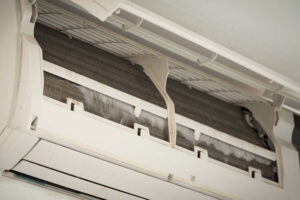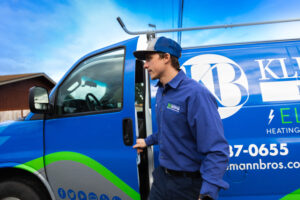Ductless vs. Traditional HVAC Systems: Which Is Right for You?

Choosing between ductless vs. traditional HVAC systems impacts your home’s comfort, energy efficiency, and long-term costs. Understanding the differences and advantages of each system helps you select the ideal system for your home.

Understanding Ductless and Traditional HVAC Systems
Traditional and ductless HVAC systems both regulate indoor temperatures but use different methods to distribute cooled or heated air.
Traditional HVAC systems
A traditional HVAC system consists of one or more units, such as a central AC, heat pump, furnace, or boiler. These cooling and heating units connect to a network of ducts to draw in and redistribute air. Traditional systems typically feature one thermostat that detects and controls temperature and a powerful single blower fan to circulate air throughout your home. They’re often found in modern homes but are less common in houses that predate central air.
Ductless HVAC systems
Ductless HVAC systems or mini-split systems use refrigerant technology similar to heat pumps and central ACs, but they operate in different ways. Like central ACs and heat pumps, ductless HVAC systems feature an outdoor compressor and indoor unit.
Instead of drawing in and distributing air via ductwork, the indoor unit delivers air to its designated zone directly. These indoor units — known as air handlers or heads — feature their thermostat, evaporator coil, blower fan, and other components that let them pull in or release heat. A copper conduit pipe containing refrigerant lines and electrical wiring connects the air handler to the outdoor unit, which extracts or disperses heat.
Many ductless systems feature multiple air handlers that connect to one outdoor unit, which enables each head to operate independently in its zone.
Energy Efficiency: Which System Saves More?
Energy efficiency is an important factor in managing consumption and long-term utility costs. Traditional and ductless systems both offer efficiency advantages, depending on the circumstances.
Mini-split models typically achieve up to 35 SEER (seasonal energy efficiency ratio), while central ACs and heat pumps currently max out at 26 SEER. SEER ratings indicate how efficiently an HVAC system converts electricity into cooling. Higher SEER ratings generally translate to lower energy bills.
Traditional HVAC systems can waste a significant amount of energy by losing conditioned or warmed air via ductwork leaks, sometimes accounting for up to 30% of heating and cooling costs. Ductless systems eliminate this problem by delivering warm or cool air directly to each room. Mini-splits especially benefit homes with inconsistent temperatures due to poor insulation or drafts because air handlers provide air to the exact space it’s needed.
Ducted systems sometimes achieve better efficiency in large homes and open floor plans because higher square footage or multiple levels require more powerful heating or cooling than a mini-split may offer. Compared to furnaces and boilers, mini-splits can suffer efficiency loss during extreme cold and may provide inadequate heating.

Installation and Upfront Costs: What To Expect
Installation costs for ductless and traditional HVAC systems vary depending on the size of your home, insulation, installation complexity, and other factors.
Replacing an AC unit, heat pump, furnace, or other HVAC unit in a home with existing ductwork typically carries lower upfront costs compared to a ductless system. Replacing separate cooling and heating units can cost more than installing equivalent mini-split heads. Modifying or repairing ductwork likewise adds to complexity and price. Homes without ductwork may require more involved labor, further driving up the cost.
Single-zone ductless systems may compare to the cost of traditional HVAC, but most homes have multiple rooms or zones that each require an air handler. Each zone and extra indoor unit increases total costs. Without ductwork, the mini-split installation process is significantly faster and less disruptive than installing a traditional system and ducts. Technicians mount the indoor heads and outdoor compressor, then connect them by running conduit lines through small holes to each room.
Long-Term Maintenance and Operating Costs
Regular maintenance is necessary for efficiency and longevity, but traditional and ductless HVAC systems have different upkeep needs.
Both systems require routine air filter replacements and general tune-ups and cleaning for blower fans, coils, and compressor units. Traditional systems need periodic ductwork cleaning to prevent blockages, mold and mildew growth, and pest infestation, and repairs are necessary for gaps or leaks. Mini-splits don’t require more frequent maintenance, but each indoor unit requires separate upkeep.
Over time, traditional HVAC may have higher operating costs than ductless systems. These systems have comparable lifespans, but mini-splits may sometimes outlast other HVAC systems.
Comfort and Zoning Capabilities: Which Is More Effective?
Traditional HVAC systems provide even temperatures throughout your home. However, if the system experiences leaks, blockages, or other airflow problems, it may struggle to circulate air efficiently, which may cause hot or cold spots. A single thermostat controls the entire system, which may lead to uneven temperatures in homes with varying insulation levels or multiple stories.
In contrast, ductless HVAC systems feature zoning capabilities that enable room-by-room temperature control. Each head operates independently so homeowners can customize temperatures according to their preferences.
Ductless systems deliver warm or cool air directly to a space, making them less likely to create uncomfortable hot or cold spots. Zoning allows you to set different temperatures for unoccupied rooms and prevent unnecessary energy consumption.
Indoor Air Quality Considerations
Ductwork gradually collects dust, dirt, pet dander, and other airborne particles and pollutants. During heating or cooling cycles, particles recirculate throughout your home, sometimes contributing to allergies, respiratory issues, and other problems. Humidity, leaks, and debris may also encourage mold growth in the ductwork, producing spores that spread in your home. Ducted systems need regular maintenance and cleaning to maintain good indoor air quality.
Without ductwork, mini-splits don’t have these same airborne contamination concerns. Many ductless systems are equipped with advanced air filters that capture small particles and improve indoor air quality. However, humidifiers, dehumidifiers, air purifiers, and other indoor air quality products integrate more easily with ducts.
Choosing the Right System for Your Home
Both traditional and ductless systems are effective HVAC solutions, but the ideal system depends on your home’s size, layout, and other variables. Consider these factors to choose the right HVAC system for your home:
- Home size and layout: Large homes with multiple rooms and levels pair well with traditional HVAC, while ductless systems benefit smaller homes, additions, or spaces with unique temperature needs.
- Existing equipment: If your home already has ducts, a traditional system may be straightforward and cost-effective. Otherwise, a ductless system avoids costly and disruptive duct installation.
- Insulation: Older homes with poor insulation may benefit more from a ductless system's efficiency in targeted areas.
- Budget: Traditional HVAC is sometimes more affordable upfront, but ductless systems may offer lower long-term maintenance and energy costs.
A Kliemann Brothers HVAC professional can assess your home’s needs to help determine the best system. We can also recommend hybrid solutions, such as combining ducted and ductless units to maximize comfort and efficiency. For example, a mini-split system may provide targeted and energy-efficient heating and cooling in specific areas without ductwork to complement a home with an existing furnace and central AC.

Contact Kliemann Bros for Your HVAC Needs
Mini-split and central air systems are effective home heating and cooling options, but maximizing their benefits means choosing the right system for your home. Contact us for an expert HVAC consultation or request a service to explore the advantages of different HVAC systems.

